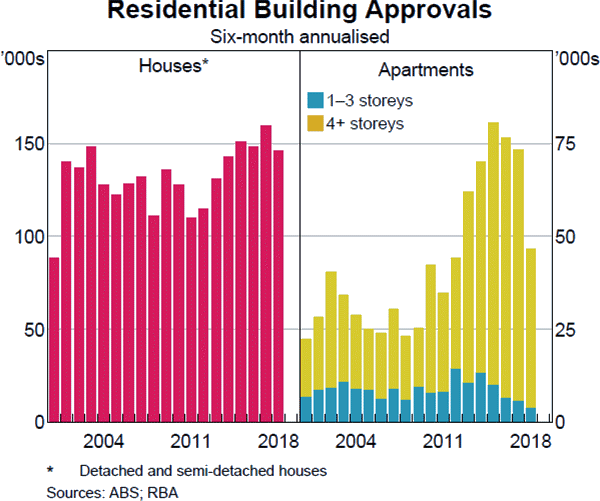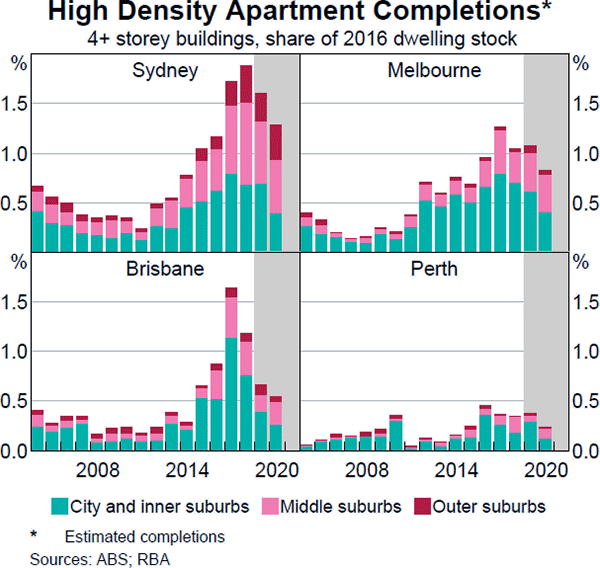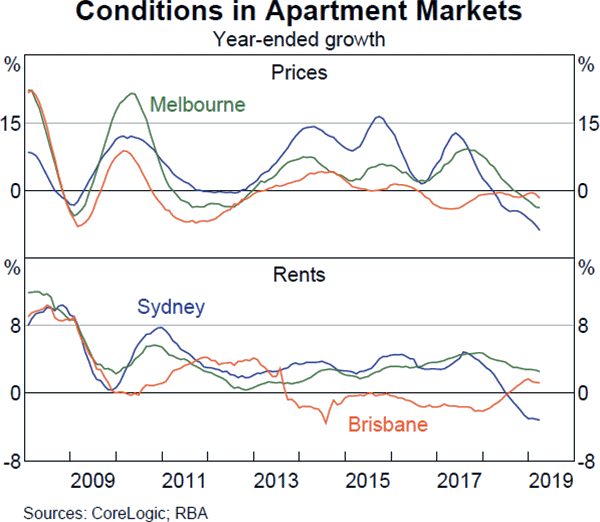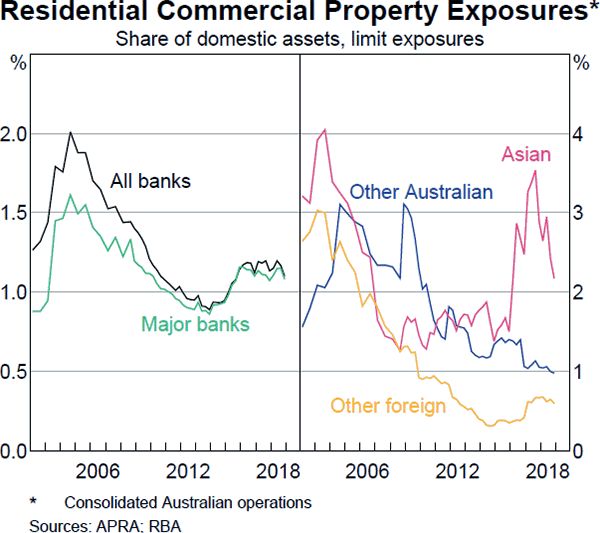Financial Stability Review – April 2019 Box C: Risks in High-density Apartment Markets
The mix of new housing being built in Australia has changed substantially over the past five years. Between 2014 and 2018, apartments accounted for roughly one-third of all new dwellings approved for construction in Australia, up from 15 per cent in the previous decade (Graph C1). Most of this increase in new apartment construction has been of high-density apartment developments, with four or more storeys. Much of this has been concentrated in inner-city and middle-ring suburbs and, in Sydney, it has also spread to suburbs in the outer ring (Graph C2).
The shift towards apartment construction nationally has been driven by a number of factors. One is that population growth, and so underlying demand for housing, has been strongest in Sydney and Melbourne. As these cities are larger, and more geographically constrained, there is a greater tendency towards more concentrated dwelling construction. The strength of investor and foreign demand in these cities has also been a factor. According to the 2016 census, roughly two-thirds of occupied apartments in Sydney and Melbourne were rented. In comparison, a little under half of semidetached dwellings and one-fifth of detached houses were rented. Liaison with developers indicates that foreign buyers were also a significant source of demand for apartments, especially in Sydney and Melbourne.[1]


The large influx of supply has the potential to exacerbate housing price declines
High-density apartment developments can exacerbate price cycles because they have long planning and development processes. When prices are rising rapidly, developers are willing to pay high prices for land on which to build apartments. Households, including investors, are willing to purchase apartments off the plan, confident that the apartment will be worth more than they paid for it when it is finally completed. And developers find it easier to get financing to undertake their projects. This continues as long as prices are rising. The large increase in supply, however, ultimately sows the seeds of a decline in prices which, if large enough, results in development becoming unattractive, new supply falling and the cycle starting again. There can be situations where developers, lenders and prospective buyers are focusing on the feasibility of individual projects but have limited information about similar, nearby projects also in the planning stage, which collectively would weigh on local apartment market conditions. The recent decline in apartment prices in Sydney and Melbourne partly reflects the expansion in supply, as well as a number of demand factors (Graph C3; also see discussion in Chapter 2).

Lower apartment prices increase the likelihood of settlement failures, but these remain low to date
The majority of high-density apartments are sold off the plan (pre-sales). These ‘pre-sales’ usually require a deposit from buyers at the time of purchase, with the settlement balance payable at the completion. The time between apartments being pre-sold and completed can be long, often a couple of years. When circumstances change between the date of pre-sale and completion, there is a risk that some buyers will not go ahead with purchasing the apartment (settlement failure). Historically, a small share of new apartments fail to settle, even when apartment market conditions are supportive (for example, due to a change in the buyer's personal situation, such as ill health or divorce).
Most buyers of off-the-plan apartments need a mortgage to pay the balance when the apartment is completed. The amount they can borrow is constrained by the bank's valuation of the property at the time of completion. If lenders' valuations are lower than purchase prices, and banks reduce the amount they are willing to lend, buyers may need to use additional savings or loans from other sources to complete the purchase. Reported falls in banks' valuations for apartments completed over the past year have not been large in aggregate. There has, however, been some variation depending on the location and quality of buildings, with valuations for high-quality buildings in sought-after areas generally remaining at or above the purchase price. In addition, banks have tightened lending standards for housing since 2015. This has typically reduced the maximum amount banks are willing to lend to buyers. Most borrowers do not borrow the maximum loan amount available, and so most borrowers would not be constrained by a change in lending criteria.[2]
However, for a minority of buyers of apartments, the tightening in lending standards has made it more difficult to complete their purchase.
Developers are taking steps to manage the risk of settlement failure
If settlement failures were to increase, then developers would be left holding completed but unsold apartments. This would affect cash flows and raises the risk that some developers might be unable to repay their loans. It would also hinder their ability to begin new projects.
Developers have responded to concerns about settlement failures in a number of ways. These measures include: prompting buyers to secure finance well ahead of the settlement date; connecting buyers with alternative lenders if required (including non-banks); lengthening settlement times; and, less frequently, providing financing directly to buyers. As a result, domestic buyers have largely been able to secure finance to complete their purchases. Foreign buyers have generally had more difficulty accessing finance and have reportedly needed to rely more on non-bank sources of finance (from offshore as well as Australian lenders).
Banks have tightened their lending standards for property development
Banks are exposed to both developers and buyers of apartments but loss rates are likely to be greater from developer lending because of the higher probability of default and loss given default. The largest losses have historically occurred for incomplete buildings.
To manage the risks associated with larger projects, banks require that developers sell a share of apartments off the plan before finance is provided and construction can commence.
Banks' pre-sale requirements have tightened over the past couple of years.[3] Banks have increasingly required that the value of pre-sales meet or exceed the total value of the loan and they have also reduced the share of pre-sales that can be to foreign purchasers.
With the banks tightening their lending standards to developers, some developers have turned to non-bank lenders. Some non-banks are active in financing residential apartment developments. Given they generally have easier lending standards, there is a risk that this leads to banks eroding their own lending standards. To date, this has not occurred (see ‘Box D: Non-bank Lending for Property’).
Banks' exposures to residential property developers are a small share of their lending, at 1 per cent of total assets. In aggregate, the size of their exposures has been steady for the past few years although at some banks it is declining (Graph C4). Banks' impaired loans for residential development have been little changed, remaining at low levels recently.

Geared investors could have difficulty making loan repayments if their rental income declines
The capacity of geared investors to maintain their loan repayments can partly depend on attracting tenants and earning rental income. Weaker apartment market conditions may encourage selling by investors struggling to meet their mortgage payments or those who want to limit potential capital losses in an environment of falling prices. These dynamics would generate further price declines. Investors in other existing residential property are also affected by declining rents and increased vacancies associated with the large increase in supply of new apartments, particularly in Sydney.
Developments to date do not appear to be resulting in widespread financial stress for geared investors. The share of non-performing housing loans held by investors has remained at a low level, below that for owner-occupiers, despite having drifted a little higher in recent years. Households have also continued to build prepayments.
While risks associated with apartment markets have increased, they appear manageable
Increased risks associated with apartment markets reflect a combination of the recent easing in market conditions and further increase in supply in the next couple of years. Risks appear highest in the Sydney market, where a considerable volume of new supply is due to be completed over the next couple of years, and the recent decline in apartment prices partly reflects demand-side factors. To date, households and developers appear to be coping well with weaker apartment market conditions. Improvements to lending standards over the past few years have been supportive in managing this adjustment.
Banks have also taken a range of measures to boost their resilience over recent years and are soundly capitalised. Furthermore, the challenges in apartment markets are occurring in a generally positive macroeconomic environment, with strong population growth, favourable labour market conditions and low interest rates likely to support housing demand going forward.
Footnotes
Rosewall T and M Shoory (2017), ‘Houses and Apartments in Australia’ RBA Bulletin, June, pp 1–11. [1]
See RBA (2018), ‘Box B: The Impact of Lending Standards on Loan Sizes’, Financial Stability Review, October, pp 32–36. [2]
See RBA (2016), ‘Box B: Banks' Exposures to Inner-city Apartment Markets’, Financial Stability Review, October, pp 25–28. [3]